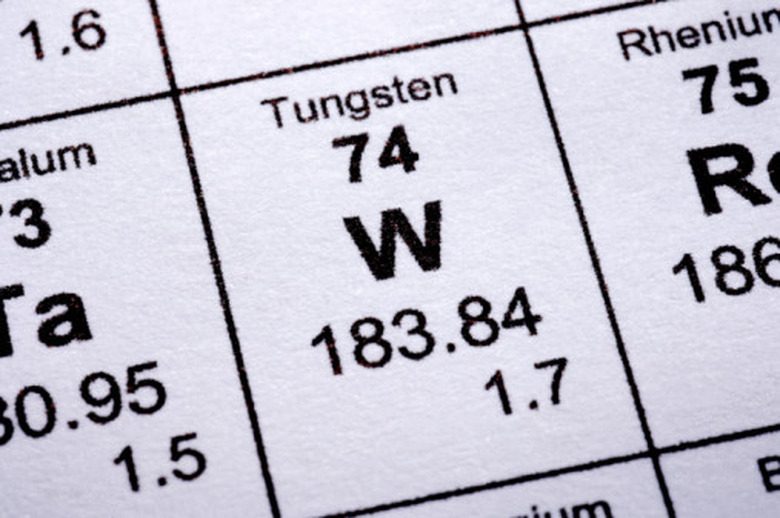What Type Of Bonding Occurs In Tungsten?
Tungsten is the 74th element of the periodic table, and is a dense gray metal with a very high melting point. It's best known for its use in filaments inside incandescent light bulbs, but its largest use is in the manufacture of tungsten carbides, as well as a number of other applications. The bonds that hold atoms together in the elemental form are an example of metallic bonding.
Electron Configuration
Electron Configuration
Electrons around atoms occupy regions of space called orbitals; the arrangement of electrons in the different orbitals of an atom is called the electron configuration. Free tungsten atoms in their ground state — lowest energy configuration — have a completely filled 4f sub-shell, four electrons in the 5d sub-shell and two electrons in the 6s sub-shell. This electron configuration can be abbreviated as follows: 5d4 6s2. In the crystal, however, the ground-state configuration actually features five electrons in the 5d sub-shell and only one electron in the 6s sub-shell. The 5d orbitals can participate in strong covalent-type bonds, where electrons are shared between atoms, but the electrons remain localized — confined to the atom to which they belong or to regions between neighboring atoms.
Metallic Bonding
Metallic Bonding
The s-electrons, by contrast, become much more delocalized, to the point where you can think of them as a sea of electrons spread throughout the metal. These electrons are not confined to any one tungsten atom but are shared between many of them. In this sense, the block of tungsten metal is a little like a very large molecule; the combination of orbitals from many tungsten atoms creates many closely spaced energy levels available for electrons to occupy. This form of bonding is called metallic bonding.
Structure
Structure
Metallic bonding helps explain the properties of metals like tungsten. The metal atoms are not constrained in a rigid framework like the atoms in a diamond crystal, so pure tungsten is, like other metals, malleable and ductile. The delocalized electrons help to hold all the tungsten atoms together. Tungsten is found in several different structures: alpha, beta and gamma tungsten. Alpha is the most stable of these, and when heated, the beta structure converts to the alpha structure.
Tungsten Compounds
Tungsten Compounds
Tungsten can form compounds and coordination complexes with various nonmetallic elements and ligands. The bonds in these compounds are covalent, meaning that electrons are shared between atoms. Its oxidation state — the charge it would have if all the bonds it formed were completely ionic — in these compounds can range from -2 to +6. It is easily oxidized at high temperatures, which is why incandescent light bulbs are always filled with an inert gas, otherwise, the tungsten filament would react with the air.
Cite This Article
MLA
Brennan, John. "What Type Of Bonding Occurs In Tungsten?" sciencing.com, https://www.sciencing.com/type-bonding-occurs-tungsten-8365093/. 24 April 2017.
APA
Brennan, John. (2017, April 24). What Type Of Bonding Occurs In Tungsten?. sciencing.com. Retrieved from https://www.sciencing.com/type-bonding-occurs-tungsten-8365093/
Chicago
Brennan, John. What Type Of Bonding Occurs In Tungsten? last modified March 24, 2022. https://www.sciencing.com/type-bonding-occurs-tungsten-8365093/
